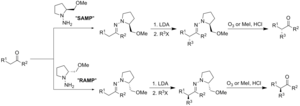chemistry, an electrophile is a chemical species that forms bonds with nucleophiles by accepting an electron pair. Because electrophiles accept electrons... 19 KB (2,321 words) - 12:01, 2 March 2024 |
positive or partially positive atom becomes an electrophile. The whole molecular entity of which the electrophile and the leaving group are part is usually... 12 KB (1,456 words) - 21:30, 14 April 2024 |
Cross electrophile coupling is a type of cross-coupling reaction that occurs between two electrophiles often catalyzed by transition metal catalyst(s)... 6 KB (740 words) - 23:27, 11 November 2023 |
Electrophilic substitution reactions are chemical reactions in which an electrophile displaces a functional group in a compound, which is typically, but not... 2 KB (244 words) - 01:58, 6 April 2023 |
attached to an aromatic system (usually hydrogen) is replaced by an electrophile. Some of the most important electrophilic aromatic substitutions are... 17 KB (2,089 words) - 10:28, 27 April 2024 |
atoms carries a partial positive charge. This makes the molecule an electrophile, and the carbon atom the electrophilic center; this atom is the primary... 8 KB (910 words) - 11:22, 17 April 2024 |
chemical compound containing a carbonyl group (C=O) acts both as the electrophile and the nucleophile in an aldol condensation. It is also called a symmetrical... 4 KB (488 words) - 21:50, 23 October 2023 |
relates to rates of certain chemical reactions. The terms nucleophile and electrophile were introduced by Christopher Kelk Ingold in 1933, replacing the terms... 17 KB (2,150 words) - 17:01, 18 April 2024 |
reacts as the nucleophile with another organic compound acting as the electrophile. This sense of reactivity may be reversed for some electron-deficient... 3 KB (315 words) - 14:47, 6 May 2024 |
 | Aldol reaction (section On the electrophile) nucleophile and electrophile are different, the reaction is called a crossed aldol reaction; on the converse, when the nucleophile and electrophile are the same... 38 KB (4,057 words) - 21:53, 6 April 2024 |
 | attacking atom or molecule, an electrophile, has low electron density and thus a positive charge. Typical electrophiles are the carbon atom of carbonyl... 66 KB (8,028 words) - 16:55, 22 April 2024 |
 | include phenyllithium (C6H5Li) and phenylmagnesium bromide (C6H5MgBr). Electrophiles are attacked by benzene to give phenyl derivatives: C 6 H 6 + E + ⟶... 9 KB (1,044 words) - 16:54, 8 May 2024 |
 | refer it as an effect produced by the presence of a reagent like an electrophile or a nucleophile, IUPAC does not define it as such. The term electromeric... 2 KB (267 words) - 14:12, 7 May 2024 |
 | σ bonds. The driving force for this reaction is the formation of an electrophile X+ that forms a covalent bond with an electron-rich, unsaturated C=C... 2 KB (243 words) - 11:21, 17 April 2024 |
Electrophilic substitution of unsaturated silanes involves attack of an electrophile on an allyl- or vinylsilane. An allyl or vinyl group is incorporated... 12 KB (1,477 words) - 15:22, 7 February 2024 |
 | form an azaenolate, which reacts with alkyl halides or other suitable electrophiles to give alkylated hydrazone species with the simultaneous generation... 23 KB (2,515 words) - 15:15, 4 April 2024 |
 | ester synthesis, wherein the diester of malonic acid reacts with an electrophile (e.g., alkyl halide), and is subsequently decarboxylated. Another variation... 41 KB (4,351 words) - 00:19, 1 May 2024 |
 | : the ability of the nucleophilic group to donate electrons and the electrophile to accept them. The former one is mainly affected by the basicity(the... 40 KB (4,839 words) - 23:49, 6 November 2023 |
 | acid anhydride derived from triflic acid. This compound is a strong electrophile, useful for introducing the triflyl group, CF3SO2. Abbreviated Tf2O,... 5 KB (466 words) - 15:47, 17 June 2023 |
the resulting enolate with an electrophile at the α-position. When the nucleophile is an enolate and the electrophile a proton, the reaction is called... 11 KB (1,405 words) - 09:10, 8 May 2023 |
another electron-deficient molecule (known as the electrophile). The molecule that contains the electrophile and the leaving functional group is called the... 12 KB (1,436 words) - 11:12, 17 April 2024 |









